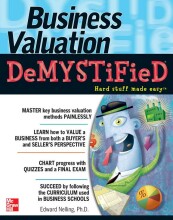Summary: A Practical Guide To Interpreting Financial Statements And Valuing Companies
- This + 400k other summaries
- A unique study and practice tool
- Never study anything twice again
- Get the grades you hope for
- 100% sure, 100% understanding
Read the summary and the most important questions on A practical guide to interpreting financial statements and valuing companies
-
1 Financial reporting
This is a preview. There are 1 more flashcards available for chapter 1
Show more cards here -
On which things do investors predominantly focus on?
- Growth
- Composition of
revenues - Development of operational earnings
- Profit
margins - Net earnings
- Cash flow figures
- Dividends
- Growth
-
On which things do regulators predominantly focus on?
- Capital
expenditures - Other investments
- Capital
-
On which things do (trade) unions predominantly focus on? Why?
- Development of staff
- Employee expenses
Earnings Dividends
magnitude of potential salary increases. - Development of staff
-
Next to his/her predominant interest, every stakeholder should also be interested in what? And why?
A company'soutlook and financial health.
These are the obvious key ingredients of a company's ability to deliver on anystakeholder expectation in the future. -
Why should every stakeholder understand how the owners view their investment?
Toanticipate likely board and management actions in the future, which mayaffect the interest of its otherstakeholders other thanshareholders . -
Why is it often very insightful to analyse the revenue breakdown companies provide in their annual reporting?
To better understand the development of growth drivers and -draggers , and of theevolution ofcompetitive pressure over time. -
2 Shareholder return
This is a preview. There are 2 more flashcards available for chapter 2
Show more cards here -
What does the return that a shareholder gets for being (partial) owner of a company consist of?
- Capital gains
Dividends Share buybacks
- Capital gains
-
What are yield plays in the investment world?
Shares that are considered to have a lower level of risk andvolatility because they are usually found among larger, more established companies. -
What are growth plays in the investment world?
Shares that will usuallyrefrain from paying outdividends and will insteadreinvest back into the company to expand. -
2.1 Capital gains
This is a preview. There are 4 more flashcards available for chapter 2.1
Show more cards here -
What is the most straightforward way in which shareholders can earn money from being shareholders in a company?
By buying shares at a certain price, which rise over time, and hence by profiting from a share price increase.
- Higher grades + faster learning
- Never study anything twice
- 100% sure, 100% understanding
Topics related to Summary: A Practical Guide To Interpreting Financial Statements And Valuing Companies
-
Shareholder return - Capital gains
-
Shareholder return - Dividends and dividend policy
-
Shareholder return - Share buybacks
-
Capital structure - Income statement
-
Capital structure - Statement of cash flows
-
Company valuation - Comparable trading multiple analysis
-
Company valuation - Discounted Cashflow Analysis (DCF) - Weighted average cost of capital
-
Company valuation - Discounted Cashflow Analysis (DCF) - Beta
-
Company valuation - Discounted Cashflow Analysis (DCF) - Terminal Value
-
Key financial ratios, growth rates, and rates of return - Margins
-
Key financial ratios, growth rates, and rates of return - Yields
-
Key financial ratios, growth rates, and rates of return - General ratios
-
Key financial ratios, growth rates, and rates of return - Rates of return































